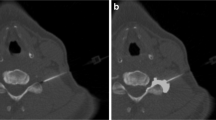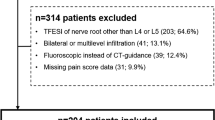Abstract
Objective
To compare the efficacy of the transforaminal approach (TFA) versus the interlaminar approach (ILA) for CT-guided epidural steroid injection (CTESI) in the treatment of persistent lumbosacral radicular pain (LRP > 6 weeks) with long-term follow-up.
Methods
Patients were prospectively assessed for pain by visual analogue scale (VAS) and functional disability (Oswestry Disability Index, (ODI)) before treatment, then 6 weeks (6W), 6 months (6 M), and 5 years (5Y) after CTESI.
Results
Overall, n = 237 patients (TFA, n = 71 and ILA, n = 166) were included, and 96 patients had 5 years of follow-up. Both groups showed a statistically significant improvement in VAS and ODI values at 6W (TFA, n = 60 and ILA, n = 146, P < 0.001 for both), at 6 M (TFA, n = 34 and ILA, n = 96, P < 0.001 for both), and at 5Y (TFA, n = 32 and ILA, n = 64, P < 0.001 for both). No significant differences were observed between the two approaches in VAS or ODI decreases at 6W (P = 0.38 and P = 0.33 respectively), 6 M (P = 0.13 and P = 0.51 respectively), or 5Y (P = 0.15 and P = 0.57 respectively). No major complications were noted.
Conclusion
Outcomes after CTESI by ILA approaches are similar to those by TFA for the treatment of persistent LRP.





Similar content being viewed by others
Abbreviations
- LRP:
-
Lumbosacral radicular pain
- ESI:
-
Epidural steroid injections
- ILA:
-
Interlaminar approach
- TFA:
-
Transforaminal approach
- MRI:
-
Magnetic resonance imaging
- IMSKR:
-
Interventional musculoskeletal radiologists
- VAS:
-
Visual analogue scale score
- ODI:
-
Oswestry Disability Index
- D0:
-
Day zero—start of the study
- 6W:
-
6 Weeks
- 6M:
-
6 Months
- 5Y:
-
5 Years
References
US Burden of Disease Collaborators. The state of US health, 1990–2010: burden of diseases, injuries, and risk factors. JAMA. 2013;310:591–608.
Martin BI, Deyo RA, Mirza SK, et al. Expenditures and health status among adults with back and neck problems. JAMA. 2008;299:656–64.
Manchikanti L, Singh V, Helm S, et al. An introduction to an evidence-based approach to interventional techniques in the management of chronic spinal pain. Pain Physician. 2009;12:E1-33.
Jacobs WCH, van Tulder M, Arts M, et al. Surgery versus conservative management of sciatica due to a lumbar herniated disc: a systematic review. Eur Spine J Off Publ Eur Spine Soc Eur Spinal Deform Soc Eur Sect Cerv Spine Res Soc. 2011;20:513–22.
Buy X, Gangi A. Percutaneous treatment of intervertebral disc herniation. Semin Interv Radiol. 2010;27:148–59.
Manchikanti L, Benyamin RM, Helm S, Hirsch JA. Evidence-based medicine, systematic reviews, and guidelines in interventional pain management: Part 3: Systematic reviews and meta-analyses of randomized trials. Pain Physician. 2009;12:35–72.
Pinto RZ, Maher CG, Ferreira ML, et al. Drugs for relief of pain in patients with sciatica: systematic review and meta-analysis. BMJ. 2012;344:e497–e497.
Benoist M, Boulu P, Hayem G. Epidural steroid injections in the management of low-back pain with radiculopathy: an update of their efficacy and safety. Eur Spine J. 2012;21:204–13.
Manchikanti L, Knezevic NN, Boswell MV, Kaye AD, Hirsch JA. Epidural injections for lumbar radiculopathy and spinal stenosis: a comparative systematic review and meta-analysis. Pain Physician. 2016;19:E365-410.
Bensler S, Sutter R, Pfirrmann CWA, Peterson CK. Is there a difference in treatment outcomes between epidural injections with particulate versus non-particulate steroids? Eur Radiol. 2017;27:1505–11.
Abdi S, Datta S, Trescot AM, et al. Epidural steroids in the management of chronic spinal pain: a systematic review. Pain Physician. 2007;10:185–212.
Buenaventura RM, Datta S, Abdi S, Smith HS. Systematic review of therapeutic lumbar transforaminal epidural steroid injections. Pain Physician. 2009;12:233–51.
Conn A, Buenaventura RM, Datta S, Abdi S, Diwan S. Systematic review of caudal epidural injections in the management of chronic low back pain. Pain Physician. 2009;12:109–35.
Fenster AJ, Fernandes K, Brook AL, Miller T. The safety of CT-guided epidural steroid injections in an older patient cohort. Pain Physician. 2016;19:E1139–46.
Rivera CE. Lumbar epidural steroid injections. Phys Med Rehabil Clin N Am. 2018;29:73–92.
Bouhassira D, Attal N, Fermanian J, et al. Development and validation of the Neuropathic Pain Symptom Inventory. Pain. 2004;108:248–57.
Dietrich TJ, Sutter R, Froehlich JM, Pfirrmann CWA. Particulate versus non-particulate steroids for lumbar transforaminal or interlaminar epidural steroid injections: an update. Skeletal Radiol. 2015;44:149–55.
Ackerman WE, Ahmad M. The efficacy of lumbar epidural steroid injections in patients with lumbar disc herniations. Anesth Analg. 2007;104:1217–1222, tables of contents.
Ghai B, Bansal D, Kay JP, Vadaje KS, Wig J. Transforaminal versus parasagittal interlaminar epidural steroid injection in low back pain with radicular pain: a randomized, double-blind, active-control trial. Pain Physician. 2014;17:277–90.
Chang-Chien GC, Knezevic NN, McCormick Z, Chu SK, Trescot AM, Candido KD. Transforaminal versus interlaminar approaches to epidural steroid injections: a systematic review of comparative studies for lumbosacral radicular pain. Pain Physician. 2014;17:E509-524.
Wybier M, Gaudart S, Petrover D, Houdart E, Laredo J-D. Paraplegia complicating selective steroid injections of the lumbar spine. Report of five cases and review of the literature. Eur Radiol. 2010;20:181–9.
Candido KD, Raghavendra MS, Chinthagada M, Badiee S, Trepashko DW. A prospective evaluation of iodinated contrast flow patterns with fluoroscopically guided lumbar epidural steroid injections: the lateral parasagittal interlaminar epidural approach versus the transforaminal epidural approach. Anesth Analg. 2008;106:638–44.
Riew KD, Yin Y, Gilula L, et al. The effect of nerve-root injections on the need for operative treatment of lumbar radicular pain. A prospective, randomized, controlled, double-blind study. J Bone Joint Surg Am. 2000;82–A:1589–93.
Kranz PG, Amrhein TJ, Gray L. Incidence of inadvertent intravascular injection during CT fluoroscopy-guided epidural steroid injections. AJNR Am J Neuroradiol. 2015;36(5):1000–7.
Bureau NJ, Moser T, Dagher JH, et al. Transforaminal versus intra-articular facet corticosteroid injections for the treatment of cervical radiculopathy: a randomized, double-blind, controlled study. AJNR Am J Neuroradiol. 2014;35:1467–74.
Author information
Authors and Affiliations
Corresponding author
Ethics declarations
Conflict of interest
The authors declare no competing interests.
Additional information
Publisher's note
Springer Nature remains neutral with regard to jurisdictional claims in published maps and institutional affiliations.
Rights and permissions
Springer Nature or its licensor (e.g. a society or other partner) holds exclusive rights to this article under a publishing agreement with the author(s) or other rightsholder(s); author self-archiving of the accepted manuscript version of this article is solely governed by the terms of such publishing agreement and applicable law.
About this article
Cite this article
Bise, S., Langlet, B., Pesquer, L. et al. Transforaminal versus interlaminar CT-guided lumbar epidural steroid injections: prospective study of 237 patients with unilateral radicular pain and up to 5 years of follow-up. Skeletal Radiol 52, 1959–1967 (2023). https://doi.org/10.1007/s00256-023-04290-y
Received:
Revised:
Accepted:
Published:
Issue Date:
DOI: https://doi.org/10.1007/s00256-023-04290-y




